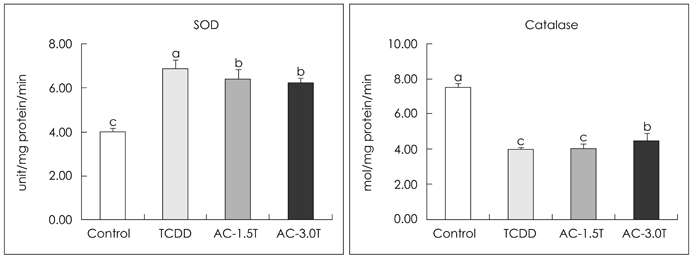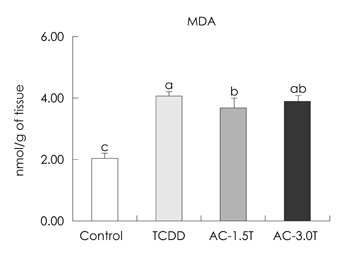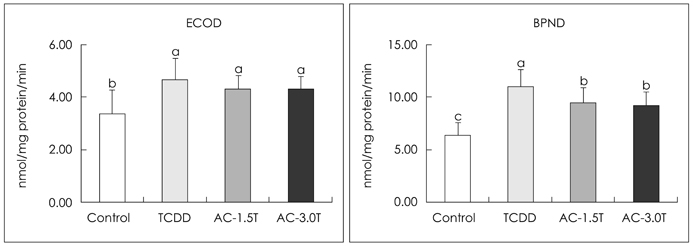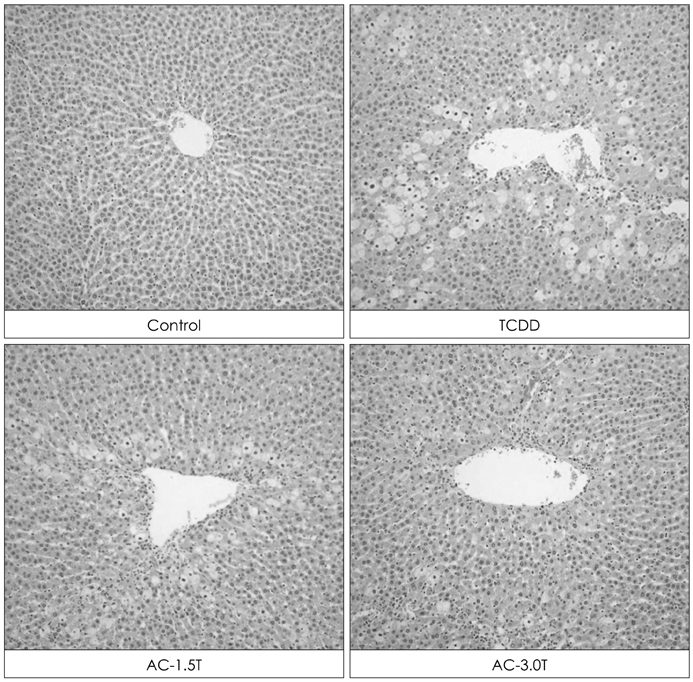J Nutr Health.
2013 Jun;46(3):207-217.
Effects of Artemisia capillaris extract on disorders of hepatic functions and lipid metabolism in rats treated with 2,3,7,8-tetrachlorodibenzo-p-dioxin (TCDD)
- Affiliations
-
- 1Department of Consumers' Life Information, Chungnam National University, Daejeon 305-764, Korea. joonho@cnu.ac.kr
- 2Department of Biomedical Laboratory Science, Daejeon University, Daejeon 300-716, Korea.
Abstract
- This study was conducted in order to investigate the effects of Artemisia capillaris (AC) extract on disorders of hepatic functions and lipid metabolism induced by 2,3,7,8-tetrachlorodibenzo-p-dioxin (TCDD), an endocrine disrupter, using male rats (SD, five weeks old) for a period of three weeks. These 37 animals were divided into four groups. AC extract was added as 1.5% or 3% levels to basal diets, respectively. TCDD (40 ug/kg B.W) was administered by intraperitoneal injection into rats after a week from the beginning of the experiment. AC extract alleviated the increase of rat's relative liver weights induced by TCDD. Thymuses of all rats treated with TCDD were apparently shrunken by approximately 80%. Levels of white blood cells (WBC), red blood cells, hemoglobin, and hematocrits were significantly increased by treatment with TCDD, however, WBC tended to decrease by AC extract diets. In hepatic function, the elevation of glutamic oxalacetic transaminase activities by TCDD treatment was diminished by AC extract diets. Serum HDL-cholesterol levels were significantly elevated by AC extract diets. The apparent increase of triglyceride levels of rat livers induced by TCDD was significantly suppressed in the AC extract diet groups. Hepatic cytosolic catalase activities significantly decreased by treatment with TCDD showed a recovering trend by AC extract diets. In histochemical observation, the fat droplets and apoptosis of hepatocytes treated with TCDD were markedly alleviated by AC extract diets. These results indicated that AC could exert recovering effects on some disorders of hepatic functions, lipids metabolism, and antioxidant activities resulting from TCDD treatment.
Keyword
MeSH Terms
Figure
Reference
-
1. Hwang SY. Protective effects of Panax ginseng on TCDD-induced toxicity in male guinea pig [PhD thesis]. Daejeon: Hannam University;1999.2. Shon YH, Nam KS. Effect of chitosan oligosaccharides on dioxin-induced CYP1A1 activity and lipid peroxidation. J Chitin Chitosan. 2001; 6(3):107–110.3. Park JB. Protective effects of cricket extract YCY against hepatotoxicity induced by 2,3,7,8 tetrachlorodibenzo-p-dioxin (TCDD) in rats [MS thesis]. Daejeon: Daejeon University;2004.4. Hanson J. Dioxin toxicity: new studies prompt debate, regulatory action. Chem Eng News. 1991; 69(32):7–14.
Article5. Jones G, Butler WH. A morphological study of the liver lesion induced by 2,3,7,8-tetrachlorodibenzo-p-dioxin in rats. J Pathol. 1974; 112(2):93–97.
Article6. Brewster DW, Matsumura F. Differential effect of 2,3,7,8-tetrachlorodibenzo-p-dioxin on adipose tissue lipoprotein lipase activity in the guinea pig, rat, hamster, rabbit, and mink. Comp Biochem Physiol C. 1989; 93(1):49–53.
Article7. Shertzer HG, Nebert DW, Puga A, Ary M, Sonntag D, Dixon K, Robinson LJ, Cianciolo E, Dalton TP. Dioxin causes a sustained oxidative stress response in the mouse. Biochem Biophys Res Commun. 1998; 253(1):44–48.
Article8. Enan E, Liu PC, Matsumura F. 2,3,7,8-tetrachlorodibenzo-p-dioxin causes reduction of glucose transporting activities in the plasma membranes of adipose tissue and pancreas from the guinea pig. J Biol Chem. 1992; 267(28):19785–19791.
Article9. Thomas TL, Kang HK. Mortality and morbidity among Army Chemical Corps Vietnam veterans: a preliminary report. Am J Ind Med. 1990; 18(6):665–673.
Article10. Fingerhut MA, Halperin WE, Marlow DA, Piacitelli LA, Honchar PA, Sweeney MH, Greife AL, Dill PA, Steenland K, Suruda AJ. Cancer mortality in workers exposed to 2,3,7,8-tetrachlorodibenzo-p-dioxin. N Engl J Med. 1991; 324(4):212–218.
Article11. Germolec DR, Henry EC, Maronpot R, Foley JF, Adams NH, Gasiewicz TA, Luster MI. Induction of CYP1A1 and ALDH-3 in lymphoid tissues from Fisher 344 rats exposed to 2,3,7,8-tetrachlorodibenzodioxin (TCDD). Toxicol Appl Pharmacol. 1996; 137(1):57–66.
Article12. Poland A, Knutson JC. 2,3,7,8-tetrachlorodibenzo-p-dioxin and related halogenated aromatic hydrocarbons: examination of the mechanism of toxicity. Annu Rev Pharmacol Toxicol. 1982; 22:517–554.
Article13. Lee JH, Hwang SY, Lim BO, Lee YS. Effects of various chitosan oligomer molecular weight levels on the disorders of lipid metabolism and immune-related factors in rats treate 2,3,7,8-tetrachlorodibenzo-p-dioxin. J Korean Soc Food Sci Nutr. 2012; 41(4):471–479.14. Webb KB, Ayres SM, Mikes J, Evans RG. The diagnosis of dioxin-associated illness. Am J Prev Med. 1986; 2(2):103–108.
Article15. Lee GD, Kim JS, Bae KO, Yoon HS. Antioxidative effectiveness of water extract and ether extract in wormwood (Artemisia montana Pampan). J Korean Soc Food Nutr. 1992; 21(1):17–22.16. Ahn BM. What is In-Jin-Sook? Artemisia capillaris, Artemisia iwayomogi, and Artemisia annua. Korean J Hepatol. 2000; 6(4):548–551.17. Park SY. The effect of extract fatty liver disease [PhD thesis]. Daejeon: Chungnam National University;2009.18. Yu YH, Lee SD, Kim YH, Oh TH, Song JC, Park SC, Yeo SG, Lee KW. The effect of Artemisia capillaris extract on hematological changes in dogs. J Vet Clin. 2003; 20(1):115–120.19. Jung MJ, Yin Y, Heo SI, Wang MH. Antioxidant and anticancer activities of extract from Artemisia capillaries. Korean J Pharmacogn. 2008; 39(3):194–198.20. Huang HC, Chu SH, Chao PD. Vasorelaxants from Chinese herbs, emodin and scoparone, possess immunosuppressive properties. Eur J Pharmacol. 1991; 198(2-3):211–213.21. Park EI, Renduchintala MS, Garrow TA. Diet-induced changes in hepatic betaine-homocysteine methyltransferase activity are mediated by changes in the steady-state level of its mRNA. J Nutr Biochem. 1997; 8(9):541–545.
Article22. Wattenberg LW, Lam LK, Fladmoe AV. Inhibition of chemical carcinogen-induced neoplasia by coumarins and alpha-angelicalactone. Cancer Res. 1979; 39(5):1651–1654.23. Reeves PG, Nielsen FH, Fahey GC Jr. AIN-93 purified diets for laboratory rodents: final report of the American Institute of Nutrition ad hoc writing committee on the reformulation of the AIN-76A rodent diet. J Nutr. 1993; 123(11):1939–1951.
Article24. United Nations Environment Programme. International Labour Organisation. World Health Organization. Polychlorinated dibenzo-p-dioxins and dibenzofurans. Environmental health criteria 88. Geneva: World Health Organization;1989.25. Bagchi D, Shara MA, Bagchi M, Hassoun EA, Stohs SJ. Time-dependent effects of 2,3,7,8-tetrachlorodibenzo-p-dioxin on serum and urine levels of malondialdehyde, formaldehyde, acetaldehyde, and acetone in rats. Toxicol Appl Pharmacol. 1993; 123(1):83–88.
Article26. Alsharif NZ, Grandjean CJ, Murray WJ, Stohs SJ. 2,3,7,8-tetrachlorodibenzo-p-dioxin (TCDD)-induced decrease in the fluidity of rat liver membranes. Xenobiotica. 1990; 20(9):979–988.
Article27. Lee JH, Hwang SY, Lee YS. Preventive effects of chitosan on the disorders of hepatic functions and lipid metabolism in rats treated with 2,3,7,8-tetrachlorodibenzo-p-dioxin (TCDD). Korean J Nutr. 2005; 38(9):689–697.28. Folch J, Lees M, Sloane Stanley GH. A simple method for the isolation and purification of total lipides from animal tissues. J Biol Chem. 1957; 226(1):497–509.
Article29. Sperry WM, Webb M. A revision of the Schoenheimer-Sperry method for cholesterol determination. J Biol Chem. 1950; 187(1):97–106.
Article30. Fletcher MJ. A colorimetric method for estimating serum triglycerides. Clin Chim Acta. 1968; 22(3):393–397.
Article31. Bansal SK, Love J, Gurtoo HL. High pressure liquid chromatographic separation of multiple forms of cytochrome P-450. Biochem Biophys Res Commun. 1983; 117(1):268–274.
Article32. Lowry OH, Rosebrough NJ, Farr AL, Randall RJ. Protein measurement with the Folin phenol reagent. J Biol Chem. 1951; 193(1):265–275.
Article33. Crapo JD, McCord JM, Fridovich I. Preparation and assay of superoxide dismutases. Methods Enzymol. 1978; 53:382–393.34. Aebi H. Catalase. In : Bergmeyer HU, Gawehn K, editors. Methods of Enzymatic Analysis. 2nd edition. New York: Academic Press;1974. p. 673–698.35. Buege JA, Aust SD. Microsomal lipid peroxidation. Methods Enzymol. 1978; 52:302–310.36. Greenlee WF, Poland A. An improved assay of 7-ethoxycoumarin O-deethylase activity: induction of hepatic enzyme activity in C57BL/6J and DBA/2J mice by phenobarbital, 3-methylcholanthrene and 2,3,7,8-tetrachlorodibenzo-p-dioxin. J Pharmacol Exp Ther. 1978; 205(3):596–605.37. Thomas PE, Lu AY, Ryan D, West SB, Kawalek J, Levin W. Multiple forms of rat liver cytochrome P-450. Immunochemical evidence with antibody against cytochrome P-448. J Biol Chem. 1976; 251(5):1385–1391.
Article38. Kim SK, Enan E, Matsumura F. Glucose effect on TCDD action on lipoprotein lipase and protein phosphorylation in isolated adipose tissue of guinea pigs. Toxic Subst Mech. 1995; 14:111–128.39. Lee SG. The therapeutic effect of Artemisia capillaris extract on hepatic damage induced by carbon tetrachloride in rats. J Vet Clin. 2005; 22(3):206–213.40. Song JH. Effect of functional food including Artemisia capillaris extracts supplementation on liver injury [MS thesis]. Busan: Pukyong National University;2007.41. Håkansson H, Johansson L, Manzoor E, Ahlborg UG. Effect of 2,3,7,8-tetrachlorodibenzoy-p-dioxin on the hepatic 7-ethoxyresorufin O-deethylase activity in four rodent species. Eur J Pharmacol. 1994; 270(4):279–284.
Article42. Hanioka N, Jinno H, Toyo'oka T, Ando M. Effect of 1,2,4-trichlorodibenzo-p-dioxin on drug-metabolizing enzymes in the rat liver. Chemosphere. 1994; 29(6):1313–1324.
Article
- Full Text Links
- Actions
-
Cited
- CITED
-
- Close
- Share
- Similar articles
-
- Preventive Effects of Chitosan on the Disorders of Hepatic Functions and Lipid Metabolism in Rats Treated with 2,3,7,8-tetrachlorodibenzo-p-dioxin (TCDD)
- Effect of organosulfur compounds on the expression of UDP-glucuronosyltransferase and thyroid hormone level in TCDD-treated rats
- Pathologic Comparative Studies on the Protective Effects by Panax Ginseng and Panax Quinquefolium for Treating 2,3,7,8-tetrachlorodibenzo-p-dioxin-induced Toxicity in Male Rats
- Effect of Artemisia Capillaris Extract on the Growth of Food-Borne Pathogens
- Teratological effect of 2,3,7,8-tetrachlorodibenzo-p-dioxin (TCDD): induction of cleft palate in the ddY and C57BL/6 mouse






